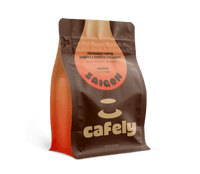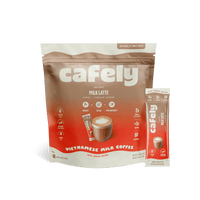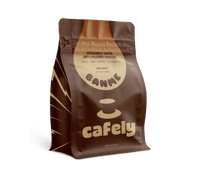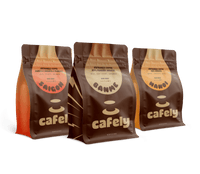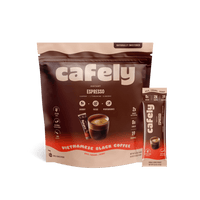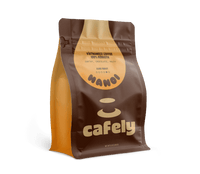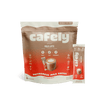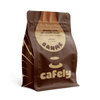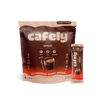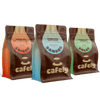In the world of coffee, there are many ways to unlock the rich flavors and aromas of your favorite beans. From the pour-over technique to the French press and the Vietnamese phin, each method brings something unique.
But which one is best? We'll explore the ins and outs of each method so you can be the judge for what works best for YOU.
Quick Comparison: Brewing Specs

Quick Comparison: Pros & Cons
There's no universal "best" brewing method. The ideal system depends on the coffee you're using, the types of flavors you like from your coffee, and how much time and effort you want to put into the brewing process.
Some people love the ritual of setting up a pour-over device; others would rather just toss some grounds in the French press, add water, and be on their way.
Here's a quick comparison of the major strengths of each brewing device and how they stack up against each other:

1. Pour-Over Coffee
Pour-over coffee involves using a filter made of paper or metal mesh and a funnel to channel the water through the grounds and into your cup.
This system is ideal for extracting the subtle flavors of coffee but requires a bit more nuance to perform correctly.
How it Works: Pour-Over Brewing
When preparing coffee for the pour-over method, it needs to be fresh and finely ground for the best results. Coffee aficionados usually weigh out the coffee, usually working with a coffee-to-water ratio of 1:15 or 1:17.
Pouring the hot water onto the coffee grounds is probably the most important part of this method. Carefully controlling the speed and the pattern of the pour gives you the best flavor, but not doing it well can make the coffee taste bitter or weak. The conical shape of the paper or metal filters also allows the coffee to drain evenly and cleanly into the cup.
There are several different styles of pour-over brewing devices. Most follow the same basic steps, but we've outlined the full process for the two most famous options — the Hario V60 and Chemex brew systems.

Pros & Cons: Pour-Over Coffee
A lot of people profess that pour-over makes the best cup of coffee. You have the greatest amount of control when it comes to brewing methods — tweaking coffee ground size, quantity, water temperature, and water pour are ways to enhance flavors and perfect your cup. The filters used for this method also don’t allow any coffee grounds or impurities to get through, creating a pure and clean coffee.
On the other hand, this method isn’t ideal for multiple cups, as usually, only one coffee can be brewed properly at a time. It can also be hard to get right, so it takes dedication and paying attention to the details to dial it in. Pour-over coffee requires full concentration, so it may not be the best choice if you want a quick brew or to make a coffee in the middle of a busy day.
2. The Traditional Phin Filter
A traditional phin filter is a brewing device used in Vietnam. It’s cherished for its ability to prepare a strong, robust coffee in minutes without the need for any expensive equipment or disposable components. Everything is built-in to the device itself.
The phin filter looks a bit like a metal cup and saucer. The cylindrical body holds the coffee grounds and water, and it has a slightly wider base that perches on top of a coffee cup. The filter allows the coffee to pass through.
How it Works: The Phin Filter
Brewing with the phin couldn’t be simpler.
Place your finely ground coffee into the main chamber of the phin and add a small amount of water. This allows the coffee to “bloom” before it starts to move through the filter. After about 45 seconds, add the rest of the water until it fills up the chamber, and allow it to drip into your mug. The full process typically takes about 5–7 minutes with this system.
Related: How to Use a Phin Filter (Brew Guide)

Pros & Cons: Phin Filters
Phin filters are ideal for traditional Vietnamese coffee, as they create a very strong brew thanks to the coffee’s slow extraction process. The resulting drink is thick and powerful, often amplified by the use of robusta, such as our HaNoi beans. Once you get the hang of it, this method is pretty simple to use. There are also very few parts to take care of, and it doesn’t require paper filters.
However, this method might not be the best for those who don’t like strong coffee, and some coffee types aren’t as suitable for use with a phin as others. If you are making multiple coffees, phins can be slightly more time-consuming as they usually make one cup at a time.
3. The French Press
A French press coffee maker may also go by the name plunger pot or cafetière, depending on where you come from. It’s a glass or sometimes metal beaker with a handle, but the lid is where the magic happens. The lid has a metal filter attached by a rod, which is used to separate the grounds from the coffee.
How it Works: French Press
To use a French press, you’ll need coarsely ground coffee, which is placed at the bottom of the chamber. Pour in some hot but not boiling water, then place on the lid with the filter plunger pulled all the way up so that it sits above the coffee in the beaker.
After about 4 or 5 minutes, slowly push the filter plunger down with even pressure, passing it through the coffee. This can then be poured into your cup and is ready to drink.

Pros & Cons: French Press
If you’re making multiple coffees, a French press is perfect. Rather than being reserved for 1 or 2 cups, French presses come in all types of sizes, from single-cup beakers all the way to 8-cup ones.
Because the filter passes through the water, rather than the water passing through the filter like in a phin or the pour-over method, a French press can create a richer flavor thanks to the full immersion of the coffee grounds. They’re also incredibly beginner-friendly, perfect for those just starting out on their coffee journeys.
With a French press, though, you do run the risk of getting sediment in your cup. It can sometimes slip past the filter, making it into your drink, especially if the coffee is more finely ground. Coarsely ground coffee is often seen as inferior to a finer grind by some, however, this is up to personal taste. Upkeep of a French press can also be slightly tricky, as they can be tough to clean fully, and most don’t take well to dishwashers.
Final Verdict: Which Method is Best?
With all things said and done, there is no true “best” method for brewing coffee. All of the ways we’ve outlined above have their pros and cons, and there will always be those who are diehard fans of one and not the other. Really, it’s all about finding what works for you and your taste.
Some general advice if you still can’t decide:
- I want the most convenient method for brewing coffee — go for either the phin or French press.
- I want the strongest coffee possible — go for the phin filter.
- I like the ritual of brewing coffee — go for either the pour-over or phin.
- I want to capture all the subtle nuances of my coffee — go for the pour-over.
- I’m brewing Vietnamese-style coffee — go for the phin.
FAQs: Pour-Over, French Press, & Phin Brewing Systems

We’ve got your additional queries covered with answers to some frequently asked questions about these three methods and anything else you might want to know about brewing coffee.
1. What’s the most inexpensive way to brew coffee?
All three methods of coffee brewing we've mentioned in this article are pretty cost-effective. Paper filters for pour-over coffee can be bought cheaply, and a good-quality French press can be around $35. Phins are more expensive on a per-cup basis but are a great long-term investment that will last you many years.
2. What water works best for brewing coffee?
A lot of people say that it's not the coffee or the process that's behind a great brew but the water used. Soft or filtered water usually produces the best results, which is great if you live in a soft water area. If you don’t, you can either use bottled water or install a water softener for your faucets.
3. What coffee beans are best for a phin?
As phins produce strong, thick coffees, it only makes sense to pair them with a strong bean like robusta, and our Cafely's BanMe Coffee and HaNoi Coffee are perfect for the job. If you find these a little too strong, then our DaLat arabica blend can still be used in a phin, too.
Related: What's the Difference Between Robusta and Arabica?
4. Can I get a reusable pour-over filter?
It is possible to get reusable stainless steel or aluminum filters to pour-over coffee, but they do result in a less clean cup than paper filters because the mesh lets oil and other residues through. Another alternative is a cloth filter, but these can be tricky to maintain.
5. My French press coffee is grainy. What did I do wrong?
There are a few reasons why your French press coffee might be grainy. You might be using coffee grounds that are too fine, so they seep through the mesh filter. Or the filter might not be fitted correctly, meaning coffee grounds leech up the sides when you plunge. You could also be plunging far too quickly — slow and steady makes for the best brews!
6. Can I brew tea using these methods?
The French press makes for an excellent tea-brewing device. However, the phin and pour-over systems are far from ideal. The water will typically flow through these devices too quickly to extract any of the flavors.
7. Which method produces the least sediment in the final cup?
The pour-over method typically yields the cleanest cup with minimal sediment, thanks to the fine paper or metal filter. The phin also filters well but can sometimes leave a few fines, while French presses are more prone to letting sediment.
8. Can I adjust the brewing process to make iced coffee with any of these methods?
Absolutely! You can brew iced coffee with all three of these methods. Simply brew your coffee as normal and pour it over ice before serving.
With that said, the phin is the best option for brewing iced coffee because it prepares a stronger, but lower volume coffee. This cools much faster when poured over ice and resists dilution as the ice melts.
9. Which brewing method is the most environmentally friendly?
The French press and phin are equally environmentally friendly because neither of these devices uses disposable filters. The pour-over typically uses disposable paper filters, but metal mesh filters can be bought for most systems to make them more eco-conscious.
